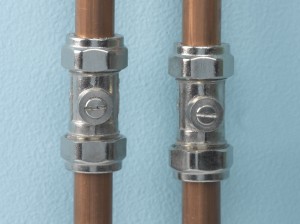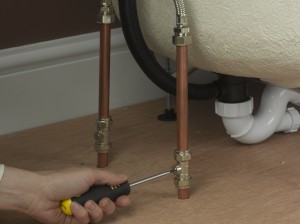Plumbing isolation valves
Plumbing isolation valves are quite simply some of the most useful devices that a DIY enthusiast can find in their home. These small valves allow you to turn off the water supply in one area of the plumbing system, so that you don’t have to drain down the whole system in order to carry out some work on a plumbing fixture or fitting.
What do plumbing isolation valves look like?

Isolation valves in ‘off’ position as the slots of the screws are running across the pipe.
Isolation valves may have little taps on them, often colour coded in red or blue, but the most commonly used in the UK, are those pictured to the right. The way the valve is turned off or on is by using a slot head screwdriver to turn the screw in the centre of the valve (only a quarter turn is required).
If the slot of the screw is aligned with the pipe, then the valve is on and so water will be flowing through it. If the slot is running across the pipe (as shown in the photo), then the valve is in the off position.
Where do you find isolation valves?
You can find isolation valves pretty much anywhere in your plumbing system, but most commonly close to the taps in your kitchen and bathroom, near your washing machine or dishwasher, and just below your toilet cistern. Basically have a look at the supply pipes below any of these fixtures, and see if your pipework has had them fitted.
Generally, you’ll always find plenty of isolation valves in newer homes but in older properties they will only have been fitted if your plumbing system has been updated. This is one of the problems of DIY plumbing in older homes – no isolation valves means draining down large sections of the plumbing system, which is really only an option for more advanced DIY plumbers (a subject for a future plumbing guide).
Fixing taps and toilets

A quarter turn is all that’s needed to turn off the supply – it doesn’t get much simpler, and that’s why I love isolation valves!
The greatest DIY use for isolation valves is when it comes to fixing plumbing fixtures and fittings such as taps and toilets. For taps, all you need do is turn the valves to the off position, open the taps to release the small amount of water that will be between the valve and the tap itself, after which, you are free to disassemble the tap, change a washer, or carry out repairs – simple. Once the work is done, just turn the valve back on.
Similarly, for a toilet, you simply turn the valve off, and you are free to empty the toilet cistern, carry out any maintenance such as fitting a new flush valve, or even remove the cistern completely if required.
Replacing kitchen and bathroom fittings
Of course, being able to shut off the water so close to a kitchen or bathroom fitting also means that not only can you fix a problem quickly, but you can also replace the fitting entirely. For much more information on how to replace, baths, basins, sinks and toilets, please have a browse through my Kitchen and Bathroom guides.
Therefore plumbing isolation valves are indeed a gift from the heavens as far as DIY is concerned; BUT, always give your plumbing system plenty of respect, don’t try anything you’re not sure of, and be aware that like any plumbing fitting, isolation valves can fail. However, in the vast majority of cases, isolation valves make plumbing much, much easier – I just love them!

hi, i was looking for information on when these plumbing isolation valves fail…. reason: – i have a tap that for intent looks to be working….. but it stops after a period of time. i thought it was limescale build up, as 1/4 turn the iso valve off and on seemed to clear it. But, after a period of time it failed again. Again, the 1/4 turn on the iso valve off and on cleared it. I am anticpating it failing agin shortly. I suspect that there may be a ‘failsafe’ in the iso valve… and that it is closing over time… is this possible in your opinion?
many thanks for your help.
dan
Hi Dan,
Mmmmm, not sure about any failsafe system but it certainly sounds like a problem with the isolation valve. If it was me, I think I’d replace the old valve with a new one and see if that does the trick.
One place where you’ll almost definitely find the answer is if you post this question on the Ultimate Handyman forum in the plumbing section (www.ultimatehandyman.co.uk) – loads of good pro plumbers on there who may well have come across this problem. There’s probably a very simple explanation, but it’s not a situation that I’ve personally come across.
Hope this helps!
Best,
Julian
Hi Julian, the water pressure in my central hearing keeps dropping and subsequently tripping the failsafe. I have traced to a leak from the isolation screw on the top of one theses isolation valves. My question is are these screws threaded, i.e. if you keep turning them past a quarter turn would they eventually come out of the valve completely? Or do they just perpetually keep turning between the on/off position? I have seen them fail in the past where they’re connected to the pipe but never from the isolation screw. I’m not a DIYer and do not relish the thought of having to get someone in to drain the system to replace it.
Any advice would be greatly appreciated.
Hi Nicholas,
If the screws turning round and round, it shouldn’t do, and because it’s leaking, there’s no good news here I’m afraid! It needs replacing, so unless you can isolate the area with other valves, then the system will need draining in order to replace the dodgy valve.
Getting the system drained from time to time is not a bad idea anyway, as you can get the pipes flushed out, some Fernox in, and generally have a good service. It also shouldn’t be as expensive a job as you may think.
Sorry not to have a quick fix!
Best,
Julian